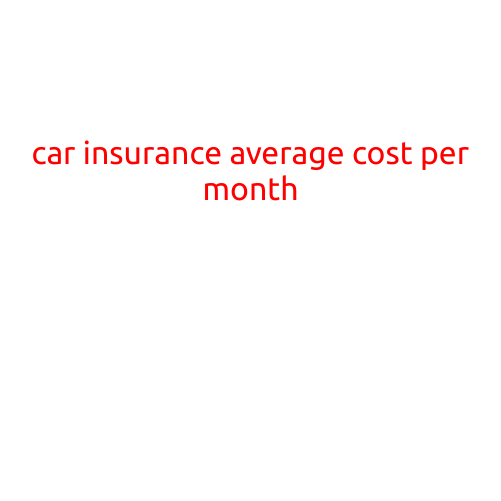
Car Insurance Average Cost per Month: A Comprehensive Guide
Are you in the market for car insurance, but unsure about what to expect when it comes to the average cost per month? You’re not alone. With so many variables to consider, it can be overwhelming to determine the right policy for your needs and budget. In this article, we’ll break down the average car insurance cost per month, exploring the factors that influence premiums and providing tips for finding the best coverage at an affordable price.
Average Car Insurance Cost per Month
The average cost of car insurance per month varies significantly depending on several factors, including:
- Location: Insurance rates differ across states and regions, with urban areas typically having higher premiums than rural areas.
- Driver demographics: Age, gender, driving record, and credit score all impact insurance costs.
- Vehicle type: Make, model, year, and condition of your car affect premiums.
- Coverage limits: The amount of coverage you choose will influence your premium.
- Deductible: The higher your deductible, the lower your premium.
According to the National Association of Insurance Commissioners (NAIC), the average annual car insurance premium in the United States is around \(1,500. Broken down monthly, this translates to approximately \)125.
Average Car Insurance Costs by State
To give you a better idea of the average cost per month, here are some state-by-state averages:
- California: $144.13
- Texas: $123.47
- Florida: $144.78
- New York: $144.39
- Illinois: $129.14
- Ohio: $113.11
- Georgia: $121.94
- Michigan: $134.17
- Arizona: $114.31
- Pennsylvania: $124.15
Factors That Influence Car Insurance Costs
To better understand how to lower your premiums, let’s delve into the factors that impact car insurance costs:
- Driver age: Younger drivers tend to have higher rates due to their higher risk of accidents.
- Driving record: A history of accidents or citations can lead to increased premiums.
- Credit score: A good credit score can result in lower insurance rates.
- Vehicle value: The value of your car affects insurance costs, with more expensive vehicles typically having higher premiums.
- Coverage limits: Higher coverage limits will generally result in higher premiums.
- Deductible: A higher deductible can reduce your premium, but increase your out-of-pocket expenses in the event of a claim.
- Optional coverage: Adding features like rental car coverage, roadside assistance, or custom equipment coverage can increase your premium.
Tips for Reducing Your Car Insurance Cost
Now that you know the average cost of car insurance per month, here are some tips to help you lower your premium:
- Shop around: Compare quotes from multiple insurance providers to find the best rates.
- Improve your credit score: A good credit score can lead to lower insurance rates.
- Raise your deductible: A higher deductible can lower your premium, but make sure you can afford the higher out-of-pocket expense in the event of a claim.
- Drop unnecessary coverage: Review your policy and eliminate coverage you don’t need, such as comprehensive coverage if your car is old or has little value.
- Take advantage of discounts: Many insurance companies offer discounts for things like good grades, being a defensive driver, or having multiple policies with the same provider.
- Consider a usage-based insurance: Some insurance companies offer usage-based insurance, which tracks your driving habits and rewards safe driving with lower premiums.
Conclusion
Car insurance costs can add up quickly, but by understanding the average cost per month and the factors that influence premiums, you can make informed decisions to find the best coverage for your needs and budget. Remember to shop around, improve your credit score, and take advantage of discounts and usage-based insurance to keep your premium as low as possible.





